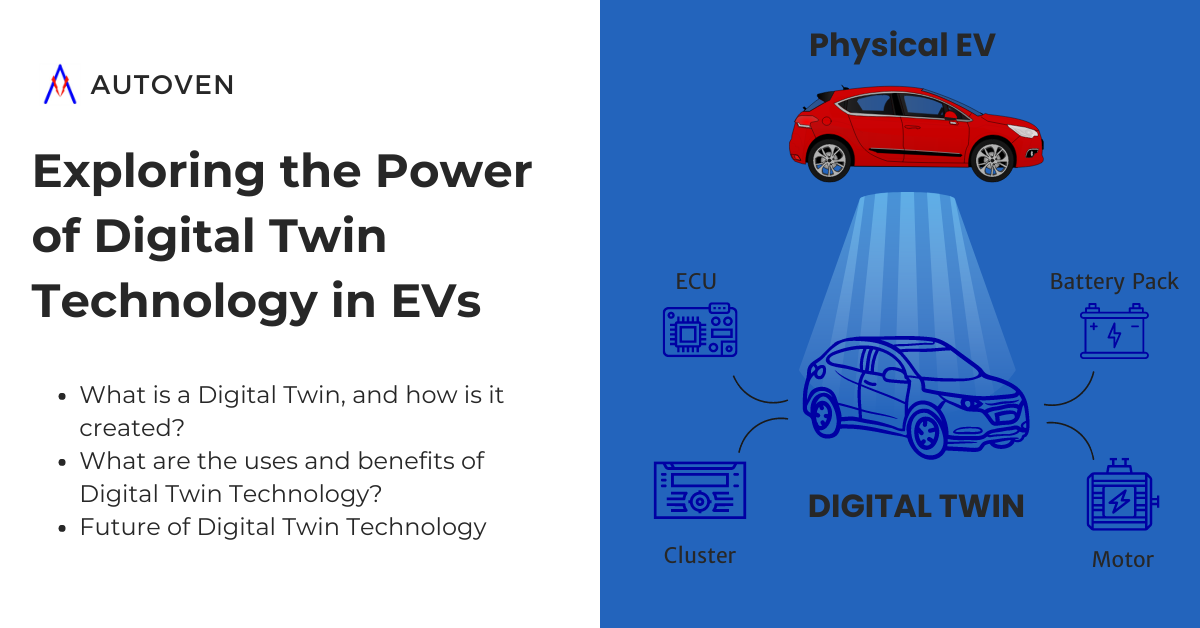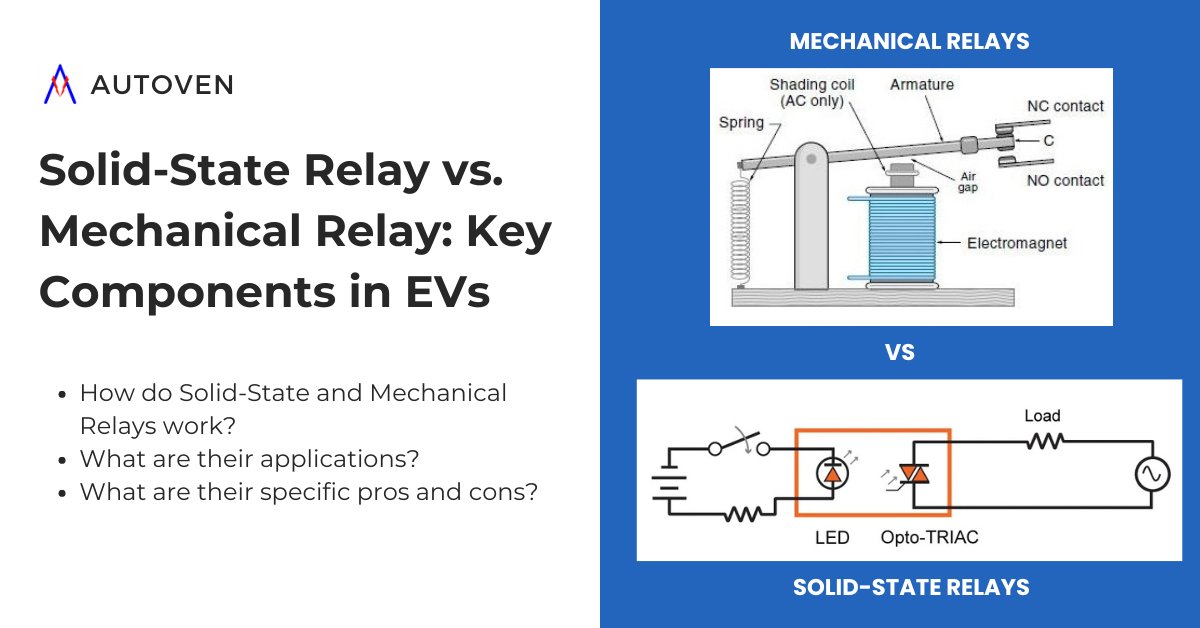Discover how digital twin technology is transforming the EV industry by enhancing performance, improving reliability, and driving innovation
Introduction
The electric vehicle (EV) industry is booming. As the demand for sustainable transportation grows, so does the need for advanced technologies to enhance EV performance. One such groundbreaking technology is the digital twin. This blog will delve into what a digital twin is, how it is created, and its uses and benefits in the EV industry.
What is a Digital Twin?
A digital twin is a virtual replica of a physical object or system. In the context of EVs, a digital twin mirrors the entire vehicle or specific components like the battery, motor, or control systems. This digital representation captures real-time data and operational characteristics, providing a comprehensive view of the vehicle’s performance. Essentially, it allows for a seamless blend of the physical and digital worlds, enabling continuous monitoring and optimization.
Digital twin technology isn’t new, but its application in the EV industry is relatively recent. It has roots in manufacturing and aerospace, where precision and real-time data are crucial. However, as EV technology advances, the benefits of digital twins become more apparent, making them an essential tool for modern electric vehicles.
How is a Digital Twin Created?
Creating a digital twin involves several steps:
Data Collection: Sensors and IoT devices embedded in the EV collect data continuously. This data includes parameters such as temperature, speed, battery status, motor performance, and more. High-quality, accurate data is the foundation of a reliable digital twin.
Data Integration: The collected data is then integrated into a digital model using digital twin software. This model is a high-fidelity replica of the physical vehicle, reflecting its real-time status and historical data. Advanced software algorithms ensure the digital twin is accurate and dynamic.
Simulation: Advanced algorithms simulate the vehicle’s behavior under various conditions. These simulations can include stress tests, performance under different weather conditions, and energy consumption patterns. Digital twins’ simulation capabilities are crucial for predicting and optimizing vehicle behavior.
Analysis: Digital twin technology analyzes the data to predict outcomes, optimize performance, and identify potential issues. This continuous analysis helps make informed decisions, improving vehicle reliability and efficiency.
Uses and Benefits of Digital Twin Technology in EVs
Digital twin technology has a wide range of applications in the EV industry. Here are some applications with their benefits:
Design and Development
Engineers use digital twins to test and refine designs. They can simulate how new components will perform without the need for physical prototypes, accelerating the design process and reducing costs. For instance, they can simulate the impact of new battery materials on overall vehicle performance before any physical battery is built.
Benefit – Digital twins provide a virtual testing ground where engineers can create more accurate and reliable designs. They reduce the need for physical prototypes. This leads to faster development cycles and cost savings.
Manufacturing
Digital twins monitor and optimize the manufacturing process, ensuring that each EV is built to the highest standards. Simulating the manufacturing process can identify and resolve potential issues before they impact production.
Benefit – Digital twins help identify and rectify issues, ensuring high-quality production. Fewer defects lead to higher quality, efficiency, and customer satisfaction.
Predictive Diagnostics
By analyzing real-time data, digital twins predict when parts will fail. Predictive diagnostics capabilities minimize unexpected breakdowns. This allows for proactive servicing and reducing downtime.
Benefit – Predictive diagnostics help reduce maintenance costs and extend the lifespan of components. For example, if a digital twin detects abnormal vibrations in the motor, it can alert the service team to inspect and repair the motor before a failure occurs.
Performance Optimization
Digital twins help optimize vehicle performance by analyzing data from various sensors. They provide insights on how to improve efficiency and extend battery life. For example, by analyzing driving patterns and battery usage, they can suggest optimal charging times and routes to maximize efficiency.
Benefit – Performance optimization leads to better efficiency and longer battery life. Continuous monitoring and optimization ensure the vehicle performs at peak under all conditions.
Driver Assistance
Digital twins enhance driver assistance systems by simulating different driving conditions. This helps improve safety features and the overall driving experience. For instance, digital twins can simulate emergency braking scenarios and optimize the vehicle’s response to ensure maximum safety.
Benefit – Digital twins enhance vehicle safety by simulating and analyzing various driving conditions. This allows for real-time optimizations, leading to a more responsive and reliable driving experience.
Fleet Management
For companies managing fleets of EVs, digital twins offer a powerful tool for monitoring and optimizing the entire fleet’s performance. They provide insights into vehicle health, usage patterns, and maintenance needs, helping fleet managers make data-driven decisions.
Benefit – Digital twins provide fleet managers with precise, real-time data on vehicle performance and health. This enables better decision-making, reducing operational costs and maximizing fleet efficiency.
Digital Twin in Action
Let’s consider an example of digital twin technology in EVs. Imagine an EV manufacturer facing a recurring issue with the battery performance in one of their popular vehicle models. Customers have reported that the battery’s range degrades faster than expected, leading to frequent charging and dissatisfaction. The problem occurs inconsistently, making it difficult to pinpoint the exact cause.
To tackle this issue, the manufacturer creates a digital twin of the entire vehicle, focusing on the battery system. It then collects and analyzes real-time data such as battery temperature, charging cycles, energy consumption, and driving patterns. By simulating different scenarios, stress tests, and past data trends, the digital twin helps engineers better understand the conditions under which the battery performance deteriorates.
Through this analysis, the digital twin reveals the specific reasons causing the impending issue. Armed with these insights, the engineering team redesigns the thermal management system and adjusts the vehicle’s software to optimize battery performance. The digital twin continues monitoring the updated system in real time, ensuring the changes have resolved the issue.
As a result, the battery’s lifespan is extended, the range remains consistent, and customer satisfaction improves. The manufacturer can now confidently address similar issues in future models, knowing that the digital twin provides a reliable tool for ongoing performance optimization.
Future of Digital Twin Technology in EVs
The future of digital twin technology in EVs is promising. As the technology evolves, we can expect even more sophisticated applications:
Autonomous Vehicles: Digital twins will be crucial in developing autonomous EVs. They will simulate and analyze countless driving scenarios, ensuring the safety and reliability of autonomous systems. By continuously learning from real-world data, digital twins will help improve autonomous vehicle decision-making algorithms.
Smart Cities: Digital twins will integrate with smart city infrastructure. They will optimize traffic flow, reduce congestion, and enhance the overall transportation experience. For example, digital twins can coordinate with traffic management systems to optimize routes for EVs, reducing travel time and energy consumption.
Sustainability: Digital twins will help in achieving sustainability goals. They will optimize energy usage and reduce emissions, contributing to a greener future. By analyzing the entire lifecycle of EVs, from production to end-of-life, digital twins can identify areas for improvement and help reduce the environmental impact.
Conclusion
Digital twin technology is revolutionizing the EV industry. It provides a comprehensive virtual replica of physical vehicles, offering numerous benefits from design to maintenance. By leveraging digital twin technology, EV manufacturers can enhance performance, reduce costs, and improve customer satisfaction. As we move towards a more sustainable future, digital twins will play a pivotal role in the evolution of electric vehicles.



